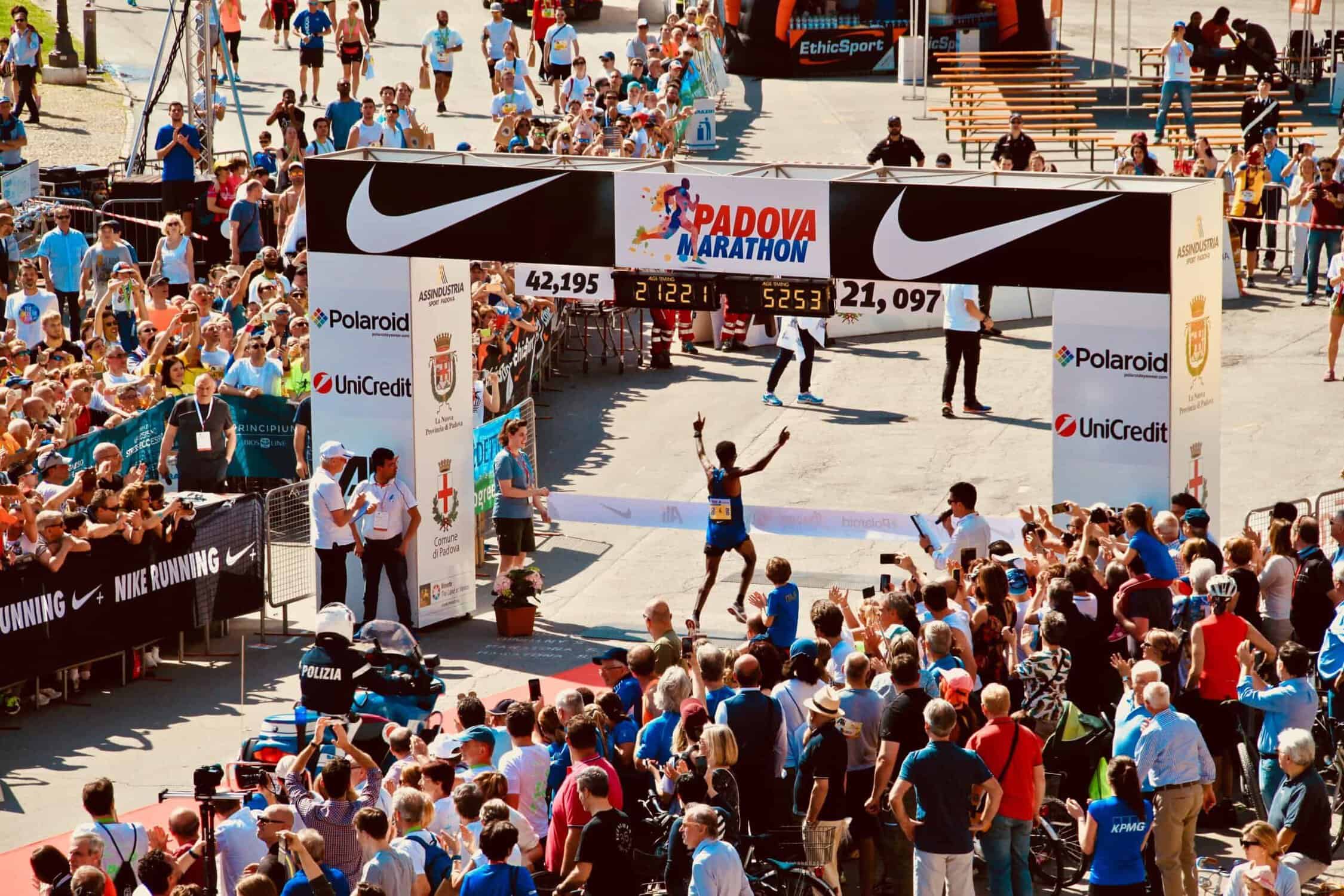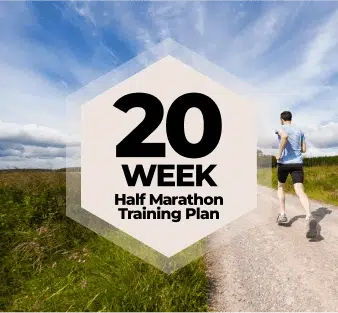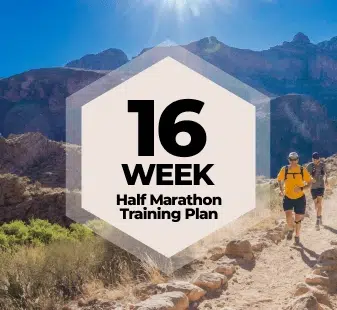If you’ve just completed a half marathon and thought “Could I do a full marathon?” as you crossed the finish line, we are here to tell you the answer. Yes. Absolutely you can. Even if it was your first half marathon, if you didn’t end up with two broken legs at the end of the race, you probably feel good enough that you were brave enough to think that thought, you can definitely do a full marathon! The key to accomplishing this goal? A specific half marathon to marathon training plan.
Thanks to your excellent half marathon training, after a few days of half marathon recovery, you will be in prime condition for the full marathon training cycle.
But slow down, don’t drop hundreds of dollars on your goal race yet. Before you begin searching for your 26.2-mile race, there are a few marathon training tips to consider. (But, if you’re overeager, here’s a list of best marathons for beginners.)
The two distances are similar. You’ll be running a few runs each week and one long run on the weekends. This will make up the bulk of your total weekly mileage.
The general idea of increased mileage over the span of 10 to 16 weeks is the same. And, you basically will require the same gear. Though, you might want to invest in two new pairs of running shoes – one for training and one for marathon racing).
The differences, though, are what separates the half marathoners from the marathoners. (And to be totally honest, there is no shame in stopping at the half distance. Most marathoners will tell you the half is actually more fun. But if you’re reading this, you don’t want to hear that.)
Leveling up from a half marathon training plan to full marathon training requires more time. It also requires the ability and determination to run longer distances.
You’re double the distance. So, expect to nearly double your weekly mileage, your on-the-run nutrition, the length of your playlist, and your level of exhaustion in day-to-day life. Is it worth it?
For many, it is.
Here, we’ll take a look at how to approach the full marathon once you’ve completed a half marathon training schedule. We’ll also cover the differences in training, and how soon you should run your next race to achieve your goals.

When to run the marathon
You likely completed a 10-20 week half marathon training plan comprised of a gradual build-up and a two-week taper, culminating in race day.
Even if you feel like you’ve been run over by a truck in the moments following 13.1 miles, your body is in terrific shape! If you want to run a full marathon, you have options.
You can either launch into full marathon training and choose a race that’s about 10 weeks away, or you can maintain this fitness in an “off-season” period and begin a 12- to 16-week marathon training plan 12 weeks before your chosen race.
Starting full marathon training immediately following half marathon training is a little risky. The chance that you’re under recovered is higher and the chance of burnout is higher.
Since you’ve dedicated 12 weeks of intense training to the half. You should assess if you’re dealing with any running injuries and if your mind and body will be ready for 10 weeks of build-up high-volume training.
Consider your half marathon recovery time
You also want to ensure that you have the time to dedicate to this next level of training.
The training mileage doubles for the full marathon, so your weekends are basically spent running and then recovering from running. Seriously, say goodbye to your non-running social life. Still, we get it, why waste the incredible fitness you have right now?
If you’re motivated, it’s possible to head right into marathon training. We’ll show you how in the training plan below.
The safer route is to maintain that base-level fitness and continue running with a marathon as a future goal. You can schedule it for the season you wish to run your goal race in or for the following year. This lets you have control over when you enter the next training cycle. You can feel confident that you’ll have the time, motivation, and physical ability to crush it.
Consider your marathon training ramp up
No matter which option you choose, once you finish your half marathon training program and race, you’ll spend the next two weeks completing a reverse taper to get you back into running safely. It’s simple.
Take a look at the taper portion of your half-marathon plan. You will run this schedule but in reverse starting after race day. So let’s say you had a two-mile shakeout run the day before the race and a three-mile training run with 10 strides two days before that.
In the first week following your half marathon race, you will run two easy miles the day after the race, then three easy miles with 10 strides two days after that, etc. until the reverse taper is completed.
If you are choosing to go into a maintenance phase, you’ll want to run between 15 and 20 miles per week. Aim for three days of easy runs and one long run. Don’t forget to continue your mobility and strength training sessions.
Your off-season is the best time to lift heavier or incorporate plyometric movements. This will get your muscles primed for marathon training.
If you’re jumping into full marathon training, see the plan below which includes an example reverse taper to follow.
Differences between training for a half and full marathon
Even the most experienced half marathoners might feel intimidated by the full distance – and for good reason! It’s a scary race distance.
But half-marathons didn’t gain popularity until the early 2000s and many recreational runners made the leap from a 10K straight to the whole 26.2. That’s to say, if you’ve already kicked butt in the half, you likely have the physical ability to make it through the full. It will just take more time and be a little longer and slower. Here are the key differences to keep in mind.
Mileage Volume
The most obvious difference between half and full training is distance. In your half marathon, your plan likely took you up to 10 or 11 miles before race day. Your highest weekly volume was likely around 20 to 25 miles depending on your level.
When it comes to the marathon, a standard plan will have your longest run at 20 miles. First-time marathoners will likely peak at a 35-mile week.
Speed
Now, just because you’re running twice as much does not mean you’ll be going twice as slow.
However, your marathon race pace might very well be a tad slower than your half marathon pace (or, you could be one of those 3-hour marathon pace runners).
And your easy mile and long run pace, which most people run too fast anyway, will also need to be slow enough to help you increase your endurance capacity and build muscle to handle the distance.
Additionally, if you are an intermediate and advanced half marathoner, you may have incorporated speed training into your 13.1 plan. Track workouts and tempo runs help improve your performance. If you’re interested in steamrolling right into the full training without a period of rest, you should consider replacing traditional speed work with 3 to 4 easy pace miles on hills unless you’re working with a running coach. It will do essentially the same thing in terms of anaerobic improvement and muscle load without wrecking your legs. Plus, it will mimic the full marathon better than a standard interval workout might.
Once you have one marathon under your belt, you can add speed sessions back into training.
Nutrition
At the very least, you’ll need to increase your calories to account for the extra miles and time on your feet. You’ll also need to make sure your hydration is dialed in.
If you can, track your protein and carb intake. How many grams you need of each macronutrient is highly individualized, but you can get a basic sense from using a calculator like this one.
If you have the means and feel confused about how to eat while training, talking to a dietician, nutritionist, or sports doc can help. Don’t forget, your on-the-run calories will need to be recalibrated.
Rest Days
Some athletes like to get really crazy and think that training for a marathon means running every day. Don’t do this. You need a plan that has at least two rest or cross-training days per week.
Rest and running recovery are important because that’s the time when your body regenerates itself – so the changes you’re making through training have a chance to take hold.
Beyond full rest days, your sleep habits are also important to help you get through marathon training. In a half marathon cycle, you could probably get away with poor-quality sleep. In marathon training, your body will get run down.
Your immune system will be weakened during those 30-and-more-mile training weeks. Start practicing good sleep hygiene now because getting seven or more hours of sound sleep per night can be the difference between quitting mid-training-cycle and making it to the finish line.
Respect the distance
Okay, so transitioning from the half marathon to a marathon is possible thanks to your current fitness level. It’s a great next goal as a serious runner. That being said, you must accept that it’s more than two times as hard.
Your half marathon time will not be a good predictor of your full marathon finish (unless you’re an elite long-distance runner.)
Experienced runners will tell you: respect the distance. What exactly does this mean?
It means that if you want to make it to the start line, feel good, and finish, you should trust your training plan.
Don’t worry about a time goal, just focus on getting to the finish.
To do that, just like in the half, the long runs will require the most focus. Preparing yourself by completing these long distances and treating them as dress rehearsals for race day (think: wear the same gear, eat the same nutrition and hydrate at the same times in practice as you will in the race), will help you on your way to becoming a marathoner.
So if you have to skip runs, don’t make it your long run. Try to be consistent when it comes to your training and take it slow. As a new runner, first-timer, or intermediate marathoner, most of your training runs should be run at a pace that allows you to carry out a full conversation. If running alone is more your style, you can give yourself the talk test by speaking positive affirmations or mantras to yourself.
Believe us, once you’re well into marathon training and need a bit of encouragement to get you through the last two miles of your 18-miler, you won’t think that advice is too wild.
Half Marathon to Marathon Training Plan
The first two weeks are your reverse taper. This plan is suitable for beginners! It only goes up to 35 total weekly miles.
If you’re looking for something more dynamic, consider Runna, rated the Best Running Training App by Tom’s Guide. You’ll get two weeks free with code HALF.
Frequently Asked Questions About Half Marathon to Marathon Training Plan
How many weeks to train for a marathon after a half marathon?
Because you’ll be dealing with both recovery from your half marathon while balancing the increase in mileage required for a marathon, we recommend 10 weeks between your half marathon and marathon. Especially, if it will be your first marathon.
What’s the best marathon for beginners?
From reviews, evaluations of the course, and time of year, our selection is the Publix Atlanta Marathon, the Chevron Houston Marathon, and the Bank of America Chicago Marathon. You can view our full list of best marathons for beginners.
Can I run a marathon without training?
We wouldn’t recommend running a marathon without training. Scaling your running mileage too quickly without an adaptation period is the right way to cause serious, prolonged injuries.





